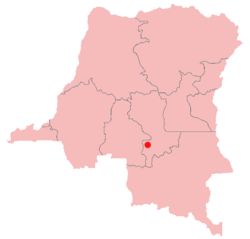Mbuji Mayi
| Mbuji-Mayi | |
|---|---|

Mbuji-Mayi Airport
|
|
 |
|
| Coordinates: 06°09′S 23°36′E / 6.150°S 23.600°ECoordinates: 06°09′S 23°36′E / 6.150°S 23.600°E | |
| Country |
|
| Province | Kasai-Oriental |
| Founded | 1914 |
| Government | |
| • Mayor | Jean Paul Ntambwe Kasanzu |
| Area | |
| • Total | 135.12 km2 (52.17 sq mi) |
| Elevation | 549 m (1,801 ft) |
| Population (2015) | |
| • Total | 3.367.582 |
Mbuji-Mayi (formerly Bakwanga) serves as the capital city of Kasai-Oriental Province in the south-central Democratic Republic of Congo. It is the third largest city in the country, following the capital Kinshasa and second largest city Lubumbashi but ahead of Kisangani and Kananga, though the exact population is not known. Estimates ranged from a 2010 CIA World Factbook estimated population of 1,480,000 to as many as 3,500,000 estimated by the United Nations in 2008.
Mbuji-Mayi lies in Luba country on the Sankuru River. The name Mbuji-Mayi comes from the local language, Tshiluba, and translates as "Goat-Water," a name deriving from the great number of goats in the region and the city's location on the Sankuru, making it a prime watering spot. Despite its large population, the city remains remote, having little connection to surrounding provinces or to Kinshasa and Lubumbashi. Air travel is provided through the Mbuji Mayi Airport.
The region where the city of Mbuji-Mayi now stands was once a cluster of villages on land owned by the Bakwanga clan. Diamonds were first discovered in the area as early as 1907, but the true value of the find was not recognised until 1913. Following the discovery, a mining camp designed to house miners and company officials of the Societé minière de Bakwanga (MIBA) was developed in the area.
The young city, known at the time as Bakwanga, grew quickly but around strict planning by MIBA, which divided the community into labor camps, mining areas and living quarters. The city's growth was not explosive, and planning was done with the needs of the mining company in mind, not the development of the region as a general population centre.
In fact, fearing theft of the company's diamond resources, the MIBA actively discouraged building in the region and closely monitored who went in and out of the region. Every person in the region needed a permit allowing them to be there, and registration at a command post that monitored the population, which made indefinite residence in the area almost impossible to establish. There was limited economic activity besides the company-run mining, with even limited agriculture, and the city's population remained low, at approximately 39,830 by the late 1950s.
...
Wikipedia
